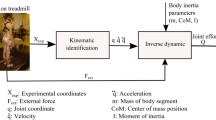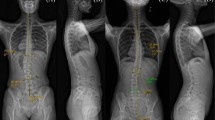Abstract
Adolescent idiopathic scoliosis (AIS) is characterized by morphological trunk modifications acting on body mass distribution. Some specific biomechanical strategies during postural regulation have been reported. Given that spinal deformity is three-dimensional, some strategy analysis resulting from different stepping directions should lead to a better understanding of the dynamic adaptation of behaviour. The aim of this study is to identify dynamic strategies of AIS patients stepping in lateral and forward directions. Ten AIS patients with a right thoracic curve and 15 controlled volunteers have been tested. Ground reaction forces (GRF) have been recorded for right-limb stepping and for left-limb stepping associated to forward and lateral directions. Force amplitudes, corresponding occurrences, impulses of stepping phases and an asymmetry index have been computed. Asymmetry and variability increased in the AIS group, compared to the control group, whatever the stepping direction is. Asymmetry for AIS patients systematically provides an increased left initiation GRF compared to a right initiation. Nevertheless, for both groups, lateral initiation shows the largest asymmetry index reported for a forward initiation. More precisely, adaptive dynamic strategies for the AIS group have been characterized by an asymmetry between right and left limbs for lateral and forward initiation. These results can be explained by the influence of scoliosis pathology on dynamic movements due to spinal deformity. A right thoracic curve leads to an extra weight on the limb, which needs to be moved; consequently, stepping initiation with the right limb was more challenging for patients than stepping with the left limb. For the AIS group, the observed variability can also depend on the ontogenesis of adaptive strategies. Lateral step initiation has to be considered as the most relevant paradigm to study scoliosis and may also serve as a clinical basis for treatment to analyse the dynamic postural control and asymmetry strategies of the scoliosis patient.



Similar content being viewed by others
References
Allard P, Chavet P, Barbier F, Gatto L, Labelle H, Sadeghi H (2004) Effect of body morphology on standing balance in adolescent idiopathic scoliosis. Am J Phys Med Rehabil 83(9):689–697. doi:10.1097/01.PHM.0000137344.95784.15
Benssoussan L, Mesure S, Viton JM, Curvale G, Delarque A (2004) Temporal, kinetic and kinematic asymmetry in gait initiation in one subject with hemiplegia. Ann Readapt Med Phys 47:611–620
Brenière Y, Do MC (1991) Control of gait initiation. J Mot Behav 23(4):235–240
Catanzariti JF, Salomez E, Bruandet JM, Thevenon A (2001) Visual deficiency and scoliosis. Spine 26(1):48–52
Champain N (2004) In: Pastel (ed) Recherche des facteurs biomécaniques dans l’aggravation des scolioses idiopathiques. Thèse biomécanique ENSAM. doi:2004ENAM0016
Chavet P, Lafortune MA, Gray JR (1997) Asymmetry of lower extremity responses to external impact loading. Hum Mov Sci 16:391–406. doi:10.1016/S0167-9457(96)00046-2
Chavet P, Bruyneel-Bertrand AV, Mesure S, Bollini G, Allard P, Berton E (2007) Scoliose idiopathique de l’adolescent et asymétrie dynamique du pas latéral. Rev Chir Orthopedique Reparatrice L’appareil Locomoteur 93(4):409–410. doi:10.1016/S0035-1040(07)90313-X
Chen P, Wang J, Tsuang Y, Liao T, Huang P, Hang Y (1998) The postural stability control and gait pattern of idiopathic scoliosis adolescent. Clin Biomech (Bristol, Avon) 13(1):52–58. doi:10.1016/S0268-0033(97)00075-2
Cheung J, Sluiter W, Veldhuizen A, Cool J, Van Horn J (2002) Perception of vertical and horizontal orientation in children with scoliosis. J Orthop Res 20:416–420. doi:10.1016/S0736-0266(01)00129-2
Cheung KM, Wang T, Poon AM, Carl A, Tranmer B, Hu Y, Luk KD, Leong JC (2005) The effect of pinealectomy on scoliosis development in young nonhuman primate. Spine 30(18):2009–2013
Chockalingam N, Dangerfield P, Rahmatalla A, El Nasri A, Cochrane T (2004) Assessment of ground reaction force during scoliotic gait. Eur Spine J 13(8):750–754. doi:10.1007/s00586-004-0762-9
Chow D, Kwok L, Cheng J, Lao M, Holmes A, Au-Yang A, Yao F, Wong M (2006) The effect of backpack weight on the standing posture and balance of schoolgirls with adolescent idiopathic scoliosis and normal controls. Gait Posture 24(2):173–181. doi:10.1016/j.gaitpost.2005.08.007
De Vita P, Bates BT (1988) Intraday reliability of ground reaction force symmetry during walking and running. Hum Mov Sci 7:73–85. doi:10.1016/0167-9457(88)90005-X
Dorfmann H, Dubousset J (2004) Scoliose idiopathique de l’adolescent. Elsevier, Amsterdam
Gauchard G, Lascombes P, Kuhnast M, Perrin P (2001) Influence of different types of progressive idiopathic scoliosis on static and dynamic postural control. Spine 26(9):1052–1058
Gaudreault N, Bertrand A, Larivière C, Deserres S, Rivard C (2005) Assessment of the paraspinal muscles of subjects presenting an idiopathic scoliosis: an EMG pilot study. BMC Musculoskelet Disord 6:14
Giakas G, Baltzopoulos V, Dangerfield P, Dorgan J, Dalmira S (1996) Comparison of gait patterns between healthy and scoliotic patients using time and frequency domain analysis of ground reaction forces. Spine 21(19):2235–2242
Kramers de Quervain I, Muller R, Stacoff A, Grob D, Stussi E (2004) Gait analysis in patients with idiopathic scoliosis. Eur Spine J 13:449–456. doi:10.1007/s00586-003-0588-x
Massion J (1990) De la posture au mouvement. In: Nougier V, Blanchi JB (eds) Pratiques sportives et modélisation du geste. CRDP, Grenoble, pp 195–213
Mesure S (2000) Posture, équilibre et locomotion: bases neurophysiologiques. In: Viel E (ed) La marche humaine, la course et le saut. Biomécanique, explorations, normes et dysfonctionnements. Masson, Paris, pp 69–90
Nascimento OF, Nielsen KD, Voigt M (2005) Influence of directional orientations during gait initiation and stepping on movement-related cortical potentials. Behav Brain Res 161:141–154. doi:10.1016/j.bbr.2005.02.031
Nault ML, Allard P, Hinse S, Le Blanc R, Caron O, Labelle H, Sadeghi H (2002) Relations between standing stability and body posture parameters in adolescent idiopathic scoliosis. Spine 27(17):1911–1917
Sahlstrand T, Ortengren R, Nachemson A (1978) Postural equilibrium in adolescent idiopathic scoliosis. Acta Orthop Scand 49(4):354–365
Sahlstrand T (1980) An analysis of lateral predominance in adolescent idiopathic scoliosis with special reference to convexity of the curve. Spine 5(6):512–518. doi:10.1097/00007632-198011000-00005
Schizas C, Kramers de Quervain I, Stussi E, Grob D (1998) Gait asymmetries in patients with idiopathic scoliosis using vertical forces measurements only. Eur Spine J 7(2):95–98. doi:10.1007/s005860050037
Simoneau M, Richer N, Mercier P, Allard P, Teasdale N (2005) Sensory deprivation and balance control in idiopathic scoliosis adolescent. Exp Brain Res 24:1–7
Viton JM, Timsit M, Mesure S, Massion J, Franceschi JP, Delarque A (2000) Asymmetry of gait initiation in patients with unilateral knee arthritis. Arch Phys Med Rehabil 81:194–200
Wicart P, Maton B (2003) Body equilibrium at the end of gait initiation: importance of ankle muscular force as evidenced in clubfoot children. Neurosci Lett 351:67–70. doi:10.1016/S0304-3940(03)00619-0
Wiener-Vacher S, Mazda K (1998) Asymmetric otolith vestibulo-ocular responses in children with idiopathic scoliosis. J Pedod 132(6):1028–1032. doi:10.1016/S0022-3476(98)70403-2
Winter D (1995) ABC of balance during standing and walking. Waterloo Biomechanics, Ontario, pp 10–42
Zabjeck K, Leroux M, Coillard C, Rivard C, Prince F (2005) Evaluation of segmental postural characteristics during quiet standing in control and idiopathic scoliosis patients. Clin Biomech (Bristol, Avon) 20(5):483–490. doi:10.1016/j.clinbiomech.2005.01.003
Author information
Authors and Affiliations
Corresponding author
Rights and permissions
About this article
Cite this article
Bruyneel, AV., Chavet, P., Bollini, G. et al. Dynamical asymmetries in idiopathic scoliosis during forward and lateral initiation step. Eur Spine J 18, 188–195 (2009). https://doi.org/10.1007/s00586-008-0864-x
Received:
Revised:
Accepted:
Published:
Issue Date:
DOI: https://doi.org/10.1007/s00586-008-0864-x




